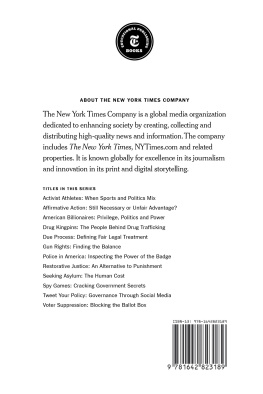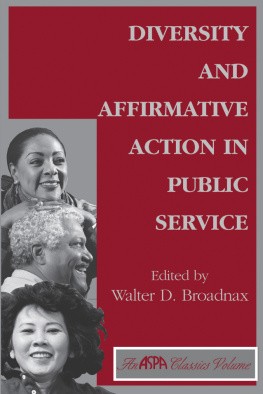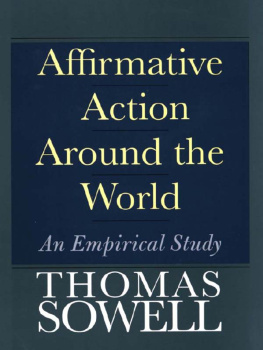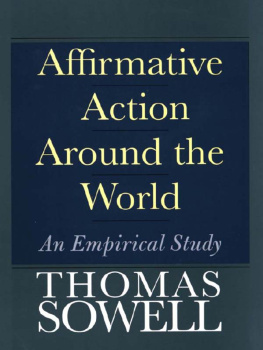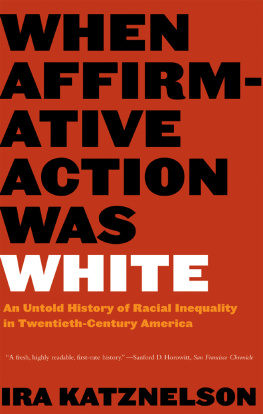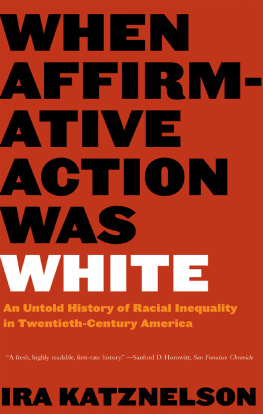Constructing Affirmative Action
Civil Rights and the Struggle for Black Equality in the Twentieth Century
Series Editors Steven F. Lawson, Rutgers University Cynthia Griggs Fleming, University of Tennessee
After the Dream: Black and White Southerners since 1965 Timothy J. Minchin and John A. Salmond
Becoming King: Martin Luther King Jr. and the Making of a National Leader Troy Jackson
Civil Rights in the Gateway to the South: Louisville, Kentucky, 19451980 Tracy KMeyer
Democracy Rising: South Carolina and the Fight for Black Equality since 1865 Peter F. Lau
Subversive Southerner: Anne Braden and the Struggle for Racial Justice in the Cold War South
Catherine Fosl
This Little Light of Mine: The Life of Fannie Lou Hamer xsKay Mills
Copyright 2011 by The University Press of Kentucky
Scholarly publisher for the Commonwealth, serving Bellarmine University, Berea College, Centre College of Kentucky, Eastern Kentucky University, The Filson Historical Society, Georgetown College, Kentucky Historical Society, Kentucky State University, Morehead State University, Murray State University, Northern Kentucky University, Transylvania University, University of Kentucky, University of Louisville, and Western Kentucky University.
All rights reserved.
Editorial and Sales Offices: The University Press of Kentucky
663 South Limestone Street, Lexington, Kentucky 40508-4008
www.kentuckypress.com
15 14 13 12 11 5 4 3 2 1
Library of Congress Cataloging-in-Publication Data
Golland, David Hamilton.
Constructing affirmative action : the struggle for equal employment opportunity / David Hamilton Golland.
p. cm.
Includes bibliographical references and index.
ISBN 978-0-8131-2997-6 (hardcover : alk. paper)
ISBN 978-0-8131-2998-3 (ebook)
1. Affirmative action programsUnited States. 2. Construction industryUnited States. 3. Minority business enterprisesUnited States. 4. Building tradesUnited States. 5. Race discriminationUnited States. 6. MinoritiesEmploymentUnited States. 7. Discrimination in employmentUnited States. I. Title.
HF5549.5.A34G65 2011
331.13'30973dc22
2010054014
This book is printed on acid-free paper meeting the requirements of the American National Standard for Permanence in Paper for Printed Library Materials.
Manufactured in the United States of America.
| Member of the Association of American University Presses |
For Lana
Preface
Richard Nixon wanted to be remembered as a civil rights president rather than Tricky Dick of the popular imagination. Historians such as Joan Hoff and, more recently, British scholar Kevin Yuill have nearly achieved that goal for him, noting the advances made in equal employment opportunity during the early 1970s. But the reality is that most of these advances were made in the courts, where Lyndon Johnsonera programs and laws were being challenged and upheld.
When pressed to defend Nixons actual civil rights accomplishments, these modern apologists point to one program: the Philadelphia Plan. They recount how the president, with his Department of Labor deputies George Shultz and Arthur Fletcher, shepherded this first affirmative action program through a heated congressional battle and challenges in the federal courts. But they minimize the real history of the Philadelphia Plan, which was developed by Johnson appointees after years of experimental attempts to integrate the skilled building construction trades. Nixon implemented the Philadelphia Plan in order to appear to be committed to civil rights, but he abandoned it after the hard-hat revolts less than six months later. In fact, Nixon was not a civil rights president at all; by 1971 his black appointees were resigning in disgust, and he even appointed a secretary of labor with a plan to resegregate vocational training.
I wrote Constructing Affirmative Action to tell the real story of Richard Nixon and civil rights. But I also wrote it to tell quite another story altogether: the integration of the building construction trades. In the 1950s blacks working in building construction were typically relegated to unskilled or residential work, while the skilled commercial construction workwith its lucrative wageswas done almost exclusively by whites. After years of struggle, the skilled unions had gained control of the hiring process, but their membershipdespite increasing calls for reform by their leadersremained racially segregated. With the postwar increase in federal construction spending, specifically urban renewal programs, the prospect of all-white skilled work crews erecting structures in predominantly black neighborhoods was one of the most obviousand gallingexamples of Jim Crow outside the American South. Civil rights organizations, labor leaders, and the federal government spent two decades working to right this wrong, and their relative successes and failures in integrating the trades are the other story I set out to tell.
This work is due in no small part to the copious assistance I have received over the years. The names are too many to mention, but I shall try. Bob Reynolds, now retired, of the George Meany Archives got me started, with patience and compassion. Jennifer Brathovde, Jeff Flannery, Joseph Jackson, Lia Kerwin, Patrick Kerwin, and Bruce Kirby made the nine-to-five at the Library of Congress Manuscript Reading Room not only tolerable but enjoyableno small feat. I am grateful to Tab Lewis at the civilian records section of the National Archives in College Park, Maryland; Allen Fisher, Claudia Anderson, Laura Eggert, and Elizabeth McLelland at the Johnson Archives in Austin; and the small but knowledgeable staffs of the Schomburg Center in Harlem, the Urban Archives at Temple University in Philadelphia, and the Historical Society of Pennsylvania. I thank the Johnson Foundation, the Colonial Dames of America, and Thomas W. Smith for the fellowships that kept me on the road, and Harold and Betsi Closter, Cynthia and Jon Simpson, and Tom and Giulia Terbush for the roofs that kept me dry.
For inspiration along the way, I would like to thank Ervand Abrahamian, Angelo Angelis, Carl Arnold, Anna Balas, Paul Fletcher, Phyllis Fletcher, Tom Kessner, Steve Levine, Vince Macaluso, Lee Malkiel, Peter Miller, Mark Peterson, Jon Powell, Chris Rosa, Brian Schwartz, the late Stephen Stearns, Randy Trumbach, Cynthia Whittaker, and Woody Zenfell. Thanks also to my mother, whose love for history inspired me from an early age to find relevance in the past; Myrna Chase, who was the first to suggest that I become a historian; Michael Holt, my M.A. adviser at the University of Virginia; and Jim Oakes, my M.Phil. adviser at the City University of New York (CUNY) Graduate Center. A large debt is owed to the members of my dissertation seminar, especially Kris Burrell, Matthew Cotter, Carla Dubose, Kate Hallgren, and Alexander Stavropoulos. I am grateful to my informal readersmy colleagues David Aliano and Joseph Sramek, my father Jeffrey Golland, and my wife Svetlana Rogachevskaya; my formal readersCarol Berkin, Joshua Freeman, and K. C. Johnson at CUNY, and Brian Purnell at Bowdoin College; and my doctoral adviser, Clarence Taylor. I would like to thank the two anonymous readers for the University Press of Kentucky, as well as Steven F. Lawson, David Cobb, Linda Lotz, and Anne Dean Watkins.


